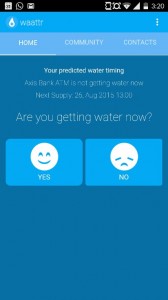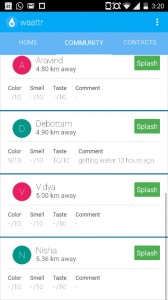This NextDrop map denotes which areas of Bangalore have received water over a specific time period. Red signifies areas that have not received water supply in more than 5 days; light blue – received water supply yesterday; dark blue – received water supply today; orange and pink – used to differentiate the different divisions/subdivisions of Bangalore.
This is a guest blog written by Raiza Talish from NextDrop, an Indian based social enterprise, which was one of M4D Utilities grantees from the first Phase of the Innovation Fund.
NextDrop is thrilled to announce that they have bagged a seven-month contract with the BWSSB (Bangalore Water Supply and Sewerage Board) to roll out services across Bangalore city!
Bangalore, with a population of more than 10 million, is estimated to have as many as 8,000 valves being operated on a two day supply cycle – controlling water supply across the city. Each engineer with the water board has to manually monitor more than 100 valves daily – a tedious and difficult task at best. Consequently, addressing all the concerns of water consumers is a huge challenge. There is also no satisfactory mechanism in place to communicate last minute changes in supply schedules to consumers, resulting in long waiting times and/or missed supply. NextDrop is thus committed to doing away with all these problems.
The NextDrop pilot was conducted in the city in November 2013, with funding from GSMA’s Mobile Enabled Community Services (now called Mobile for Development Utilities) Innovation Award. During this time, NextDrop mapped 40% of Bangalore city’s water distribution and supply network. Under the pilot, three full divisions (South, North East & Central Bangalore) and two sub-divisions (SW2 and SW3 from the South West division) were mapped, and about 7,000 residents enrolled under the NextDrop water alert system. The BWSBB-NextDrop contract now allows NextDrop to map the remaining 60% of the city, providing its water-network system to at least 300,000 people in seven months. The NextDrop Smart Grid will also allow the BWSSB to have access to real-time data monitoring services pertaining to water distribution and supply throughout the city, and will give their engineers insights while taking the necessary action to fix water-related problems.
NextDrop, a civic start-up with a BIG vision, was founded in 2011 by Anu Sridharan, Quijano Flores and Devin Miller. The Bangalore-based company is a for-profit enterprise with a social mission: to rid the world of its water problems. Their vision is simple – to link the private sector, government utilities and citizens to create an endless loop of timely service provision and feedback collection, and bridge all the gaps in between. And to do this, they try to harness the latest, cutting edge technology.
NextDrop currently offers three products – SMS services, the Waattr app and a water smart lite grid. They use real-time data to inform their subscribers about when they’re receiving water, when there’s a delay, when pipe damage is likely to affect them, and when someone in the community has water updates to share. The information stored on the water-smart lite grid from the crowd sourced data is then analysed and used to predict where water resources will most probably be found, which water solutions can work for what populations, and potentially fix problems before they even occur.
The beta version of the Waattr app is freely available to consumers to download on the Google Play Store.


NextDrop encourages the people of Bangalore to contribute towards building their NextDrop Water Smart Grid in the city and helping to solve water problems across the region by downloading the app, testing it and giving them feedback. The Waattr app is a one-of-a-kind crowdsourcing app that collects information from users about their water supply. It allows users to log whether they’re getting water or whether they’re waiting for water. This information is then used to generate a hydromap- so that users can see who around their locality are facing the same water problems. The app also asks users to rate the quality of the water that they receive, using three criteria – colour, smell and taste. These are rated on a 0-10 scale, with 0 being the worst quality indicator, and 10 being the best. There is also space for users to enter their own comments about the water supply, so that more personalised information and data can be collected. NextDrop hopes to have 50 million users registered on the Waattr app by 2020.

